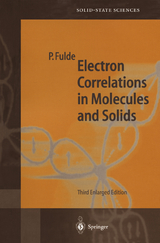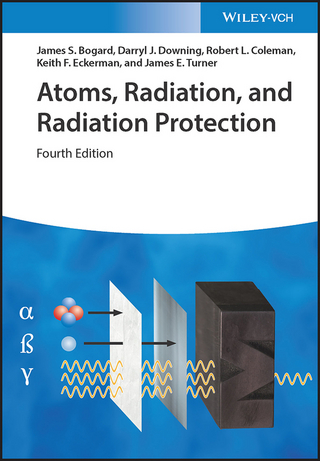Electron Correlations in Molecules and Solids
Springer Berlin (Verlag)
978-3-540-59364-5 (ISBN)
1. Introduction.- 2. The Independent-Electron Approximation.- 2.1 Starting Hamiltonian.- 2.2 Basis Functions and Basis Sets.- 2.3 Self-Consistent Field Approximation.- 2.4 Simplified SCF Calculational Schemes.- 2.5 Koopmans' Theorem.- 2.6 Homogeneous Electron Gas.- 2.7 Local Exchange Potential - The Xa Method.- 2.8 Shortcomings of the Independent-Electron Approximation.- 2.9 Unrestricted SCF Approximation.- 3. Density Functional Theory.- 3.1 Thomas-Fermi Method.- 3.2 Hohenberg-Kohn-Sham Theory.- 3.3 Local-Density Approximation.- 3.4 Results for Atoms, Molecules, and Solids.- 3.5 Extensions and Limitations.- 4. Quantum-Chemical Approach to Electron Correlations.- 4.1 Configuration Interactions.- 4.2 Many-Body Perturbation Theory.- 5. Cumulants, Partitioning, and Projections.- 5.1 Cumulant Representation.- 5.2 Projection and Partitioning Techniques.- 5.3 Coupled-Cluster Method.- 5.4 Comparison with Various Trial Wavefunctions.- 5.5 Simplified Correlation Calculations.- 6. Excited States.- 6.1 CI Calculations and Basis Set Requirements.- 6.2 Excitation Energies in Terms of Cumulants.- 6.3 Green's Function Method.- 6.4 Local Operators.- 7. Finite-Temperature Techniques.- 7.1 Approximations for Thermodynamic Quantities.- 7.2 Functional-Integral Method.- 7.3 Monte Carlo Methods.- 8. Correlations in Atoms and Molecules.- 8.1 Atoms.- 8.2 Hydrocarbon Molecules.- 8.3 Molecules Consisting of First-Row Atoms.- 8.4 Strength of Correlations in Different Bonds.- 8.5 Polymers.- 8.6 Photoionization Spectra.- 9. Semiconductors and Insulators.- 9.1 Ground-State Correlations.- 9.2 Excited States.- 10. Homogeneous Metallic Systems.- 10.1 Fermi-Liquid Approach.- 10.2 Charge Screening and the Random-Phase Approximation.- 10.3 Spin Fluctuations.- 11. Transition Metals.- 11.1 CorrelatedGround State.- 11.2 Excited States.- 11.3 Finite Temperatures.- 12. Strongly Correlated Electrons.- 12.1 Molecules.- 12.2 Anderson Hamiltonian.- 12.3 Effective Exchange Hamiltonian.- 12.4 Magnetic Impurity in a Lattice of Strongly Correlated Electrons.- 12.5 Hubbard Hamiltonian.- 12.6 The t - J Model.- 12.7 Slave Bosons in the Mean-Field Approximation.- 12.8 Kanamori's t-Matrix Approach.- 13. Heavy-Fermion Systems.- 13.1 The Fermi Surface and Quasiparticle Excitations.- 13.2 Model Hamiltonian and Slave Bosons.- 13.3 Application of the Noncrossing Approximation.- 13.4 Variational Wavefunctions.- 13.5 Quasiparticle Interactions.- 13.6 Quasiparticle-Phonon Interactions Based on Strong Correlations.- 14. Superconductivity and the High-Tc Materials.- 14.1 The Superconducting State.- 14.2 Electronic Properties of the High-Tc Materials.- 14.3 Other Properties of the Cuprates.- 14.4 Heavy Fermions in Nd2_xCexCuO4.- B. Derivation of Several Relations Involving Cumulants.- C. Projection Method of Mori and Zwanzig.- D. Cross-Over from Weak to Strong Correlations.- E. Derivation of a General Form for ??).- F. Hund's Rule Correlations.- G. Cumulant Representation of Expectation Values and Correlation Functions.- H. Diagrammatic Representation of Certain Expectation Values.- I. Derivation of the Quasiparticle Equation.- J. Coherent-Potential Approximation.- K. Derivation of the NCA Equations.- L. Ground-State Energy of a Heisenberg Antiferromagnet on a Square Lattice.- M. The Lanczos Method.- References.
| Erscheint lt. Verlag | 9.10.1995 |
|---|---|
| Reihe/Serie | Springer Series in Solid-State Sciences |
| Zusatzinfo | XIV, 483 p. 7 illus. |
| Verlagsort | Berlin |
| Sprache | englisch |
| Maße | 155 x 235 mm |
| Gewicht | 762 g |
| Themenwelt | Naturwissenschaften ► Physik / Astronomie ► Angewandte Physik |
| Naturwissenschaften ► Physik / Astronomie ► Atom- / Kern- / Molekularphysik | |
| Schlagworte | Cluster • Correlation Energy • Electron Correlations • Festkörper • Heavy Fermions • Hubbard Models • Molecule • Molekül • particles • Potential • Projection Techniques • self-consistent field • semiconductor • Spectra |
| ISBN-10 | 3-540-59364-0 / 3540593640 |
| ISBN-13 | 978-3-540-59364-5 / 9783540593645 |
| Zustand | Neuware |
| Haben Sie eine Frage zum Produkt? |
aus dem Bereich




